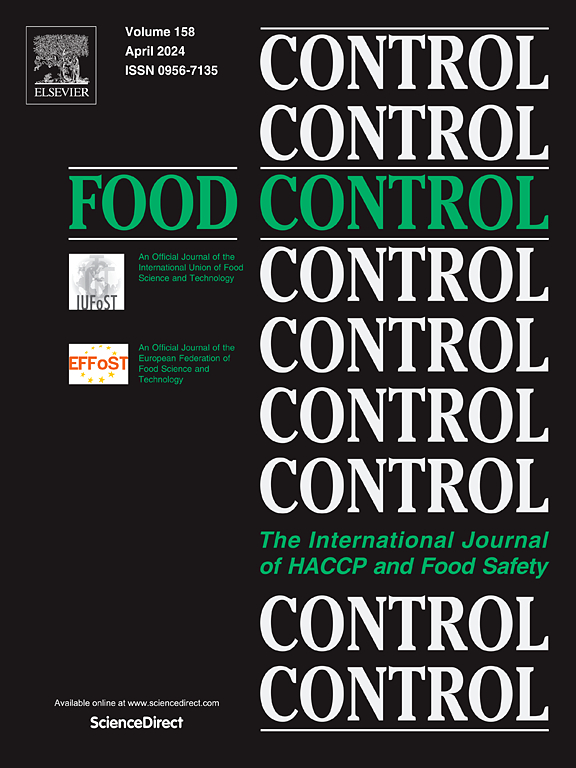利用高光谱成像技术结合深度学习,在热加工过程中监测鱼糜的理化特性和凝胶质量
IF 5.6
1区 农林科学
Q1 FOOD SCIENCE & TECHNOLOGY
引用次数: 0
摘要
鱼类加工业在保持鱼糜产品质量方面面临重大挑战,这可能会影响消费者的吸引力和整体产品质量。本研究探讨了利用高光谱成像技术快速、无损地在线监测鱼糜两段水浴加热过程中的质量变化。鱼糜样品分别在40°C加热30分钟和90°C加热20分钟,每5分钟收集一次关键质量指标的数据,包括凝胶强度、保水能力和白度。为了全面评价鱼糜在两阶段加热过程中的质量变化,利用高光谱成像技术建立了两个模型:偏最小二乘(PLS)模型和卷积神经网络长短期记忆(CNN-LSTM)模型。建立了一个单独的CNN-LSTM模型来同时预测多个质量指标。虽然预测单个质量指标的最优模型略优于多指标预测模型(Rp2 >;0.93, RPD >3.9),两种方法均有效。此外,还对加热过程中观察到的质量变化进行了可视化分析。本研究表明,高光谱成像与化学计量学相结合,为预测鱼糜热加工过程中的质量变化提供了一种无损、快速、在线的方法。这种方法解决了行业对创新质量评估工具的需求,并有可能提高加工鱼糜市场的产品质量和消费者满意度。本文章由计算机程序翻译,如有差异,请以英文原文为准。
Physicochemical properties and gel quality monitoring of surimi during thermal processing using hyperspectral imaging combined with deep learning
The fish processing industry faces significant challenges in maintaining the quality of surimi products, which can impact consumer appeal and overall product quality. This study investigated the use of hyperspectral imaging for rapid, non-destructive, online monitoring of quality changes during two-stage water bath heating of surimi. Surimi samples were heated at 40 °C for 30 min and 90 °C for 20 min, with data collected every 5 min on key quality indicators, including gel strength, water-holding capacity, and whiteness. To comprehensively evaluate the quality changes of surimi during the two-stage heating process, two models were developed using hyperspectral imaging: a partial least squares (PLS) model and a convolutional neural network-long and short-term memory (CNN-LSTM) model. A separate CNN-LSTM model was created to predict multiple quality indicators simultaneously. Although the optimal model for predicting individual quality indicators slightly outperformed the multi-indicator predicting model ( > 0.93, RPD >3.9), both approaches were effective. Additionally, the quality changes observed during the heating process were visualized and analyzed. This study demonstrates that hyperspectral imaging, combined with chemometrics, offers a non-destructive, rapid, and online method for predicting quality changes during the thermal processing of surimi. This approach addresses the industry's need for innovative quality assessment tools and has the potential to enhance product quality and consumer satisfaction in the processed surimi market.
求助全文
通过发布文献求助,成功后即可免费获取论文全文。
去求助
来源期刊

Food Control
工程技术-食品科技
CiteScore
12.20
自引率
6.70%
发文量
758
审稿时长
33 days
期刊介绍:
Food Control is an international journal that provides essential information for those involved in food safety and process control.
Food Control covers the below areas that relate to food process control or to food safety of human foods:
• Microbial food safety and antimicrobial systems
• Mycotoxins
• Hazard analysis, HACCP and food safety objectives
• Risk assessment, including microbial and chemical hazards
• Quality assurance
• Good manufacturing practices
• Food process systems design and control
• Food Packaging technology and materials in contact with foods
• Rapid methods of analysis and detection, including sensor technology
• Codes of practice, legislation and international harmonization
• Consumer issues
• Education, training and research needs.
The scope of Food Control is comprehensive and includes original research papers, authoritative reviews, short communications, comment articles that report on new developments in food control, and position papers.
 求助内容:
求助内容: 应助结果提醒方式:
应助结果提醒方式:


